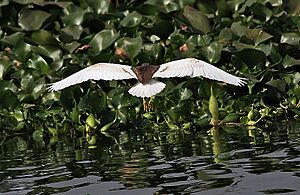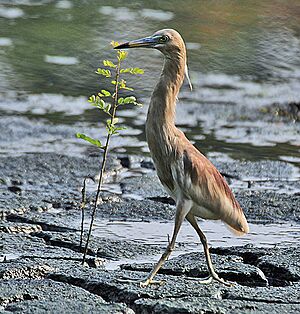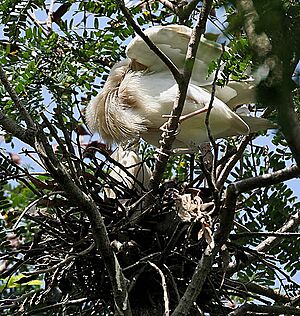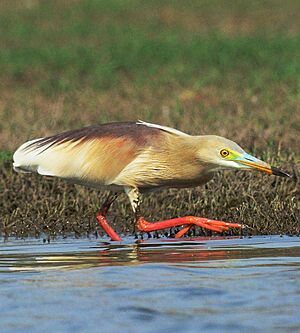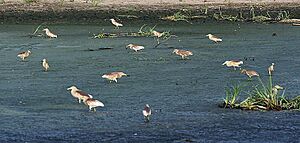Indian pond heron facts for kids
Quick facts for kids Indian pond heron |
|
|---|---|
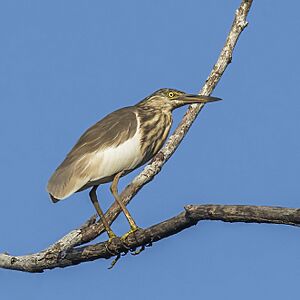 |
|
| In non-breeding plumage (Sri Lanka) | |
 |
|
| Breeding plumage (India)
|
|
| Conservation status | |
| Scientific classification | |
| Genus: |
Ardeola
|
| Species: |
grayii
|
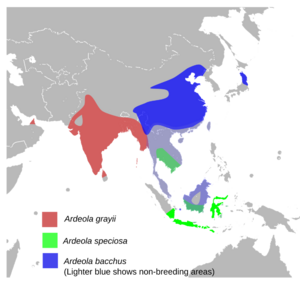 |
|
| Synonyms | |
|
Ardeola leucoptera |
|
The Indian pond heron or paddybird (Ardeola grayii) is a small heron. This bird comes from parts of the world like southern Iran, the Indian subcontinent, Burma, and Sri Lanka. They are very common but can be hard to spot. This is because they often hunt for food near water or even rest near people's homes.
They are easy to spot when they fly. Their bright white wings flash against their streaky olive and brown body colors that help them hide. They are so well camouflaged that you can get very close before they fly away. Because of this, people used to think they were short-sighted or even blind.
Contents
About the Indian Pond Heron
Indian pond herons are strong birds with short necks and thick bills. Their backs are buff-brown. In summer, adult birds grow long neck feathers. When they fly, their dull body colors change to bright white wings, making them very noticeable.
They look a lot like squacco herons, Ardeola ralloides, but their backs are darker. Further east, you'll find the Chinese pond herons, Ardeola bacchus, which are similar.
Sometimes, during the breeding season, some herons have red legs. Scientists think this might be a special genetic trait, not a normal change for all adults.
This bird was first described by Colonel W. H. Sykes in 1832. Its scientific name honors John Edward Gray. Pond herons usually stay quiet. But they might make a harsh croak if they are scared or near their nests.
Heron Behavior and Life
These herons are very common in India. They usually hunt alone. However, many of them might feed together during dry seasons. This happens when small wetlands have lots of prey. They also gather in groups to nest. Sometimes, they even look for food at garbage dumps.
During dry times, they might hunt on well-watered lawns or even dry grassy areas. When they are looking for food, you can get quite close to them. They only fly away when you are very near. They sometimes gather in groups to rest. These roosts are often in trees over busy city areas.
What Do Herons Eat?
Indian pond herons usually find food in marshy wetlands. They often feed at the edge of ponds. They also use floating plants like water hyacinth to reach deeper water. Sometimes, they might swim or catch fish from the air. They have even been seen flying and catching fish that jump out of the water.
They sometimes fly low over the water. This helps them scare frogs and fish towards the shore. They have also been seen picking up bread crumbs. They drop these crumbs on the water to attract fish.
Their main food includes small crabs, water insects, fish, tadpoles, and sometimes leeches. Away from wetlands, these herons eat insects like crickets, dragonflies, and bees. They also eat fish and amphibians.
Reproduction and Nesting
The breeding season starts when the monsoon rains begin. They build nests in small groups. Often, they nest with other wading birds. Their nests are usually platforms of sticks in trees or bushes. Most nests are built about 9 to 10 meters high in large, leafy trees.
The male heron gathers the nest materials. The female then builds the nest. They lay three to five eggs. The eggs hatch at different times, taking 18 to 24 days. Both parents feed the young birds. Fish are the main food given to the young. If a nest site is not disturbed, the herons might use it again year after year.
Dangers to Herons
Indian pond herons have few natural enemies. However, injured birds might be caught by birds of prey.
Scientists have found some viruses and parasites in these birds. Antibodies to Japanese encephalitis and West Nile virus have been found in pond herons.
Herons in Culture
The way these birds stand still and only fly away at the last moment has led to many folk beliefs. People often thought they were partly blind. In Sri Lanka, the bird is called kana koka, which means "half-blind heron" in the Sinhala language.
In the Hindustani phrase "bagla bhagat," the heron is used to describe someone who pretends to be good but is actually a "wolf in sheep's clothing." The paddy-bird also appears in the Hitopadesha, an ancient Indian collection of fables. In one story, it gets hurt to save a king.
Early English writers in India often wrote about how surprising it was to see the heron's colors change. Phil Robinson described the bird as one that "sits all dingy gray and flies all white." In the past, many people in India used to eat these birds.
During the time when bird feathers were very popular, feathers from the "paddy bird" were collected. These feathers were then sent to Britain.



